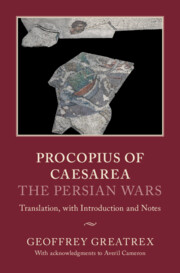Refine search
Actions for selected content:
23990 results in Ancient history
2 - Court Spaces
-
-
- Book:
- The Roman Emperor and his Court c. 30 BC–c. AD 300
- Published online:
- 29 September 2022
- Print publication:
- 20 October 2022, pp 32-78
-
- Chapter
- Export citation
Contents
-
- Book:
- The Roman Emperor and his Court c. 30 BC–c. AD 300
- Published online:
- 29 September 2022
- Print publication:
- 20 October 2022, pp vii-viii
-
- Chapter
- Export citation
11 - Imperial Journeys
-
-
- Book:
- The Roman Emperor and his Court c. 30 BC–c. AD 300
- Published online:
- 29 September 2022
- Print publication:
- 20 October 2022, pp 267-287
-
- Chapter
- Export citation
Abbreviations
-
- Book:
- The Roman Emperor and his Court c. 30 BC–c. AD 300
- Published online:
- 29 September 2022
- Print publication:
- 20 October 2022, pp xvii-xviii
-
- Chapter
- Export citation
Introduction: The Sources for the Roman Court
-
-
- Book:
- The Roman Emperor and his Court c. 30 BC–c. AD 300
- Published online:
- 29 September 2022
- Print publication:
- 20 October 2022, pp 1-9
-
- Chapter
- Export citation

Procopius of Caesarea: The Persian Wars
- Translation, with Introduction and Notes
-
- Published online:
- 13 October 2022
- Print publication:
- 03 November 2022
Chapter 6 - Campania and Cisalpine Gaul:
-
- Book:
- Plants, Politics and Empire in Ancient Rome
- Published online:
- 06 October 2022
- Print publication:
- 13 October 2022, pp 198-232
-
- Chapter
- Export citation
Acknowledgments
-
- Book:
- Plants, Politics and Empire in Ancient Rome
- Published online:
- 06 October 2022
- Print publication:
- 13 October 2022, pp xii-xiii
-
- Chapter
- Export citation
Index
-
- Book:
- Plants, Politics and Empire in Ancient Rome
- Published online:
- 06 October 2022
- Print publication:
- 13 October 2022, pp 344-360
-
- Chapter
- Export citation
Figures
-
- Book:
- Plants, Politics and Empire in Ancient Rome
- Published online:
- 06 October 2022
- Print publication:
- 13 October 2022, pp ix-x
-
- Chapter
- Export citation
Chapter 5 - Of Peaches and Peach Trees
-
- Book:
- Plants, Politics and Empire in Ancient Rome
- Published online:
- 06 October 2022
- Print publication:
- 13 October 2022, pp 177-197
-
- Chapter
- Export citation
Chapter 2 - Arboriculture, ‘Botanical Imperialism’, and Plants on the Move
-
- Book:
- Plants, Politics and Empire in Ancient Rome
- Published online:
- 06 October 2022
- Print publication:
- 13 October 2022, pp 50-87
-
- Chapter
- Export citation
Conclusions
-
- Book:
- Plants, Politics and Empire in Ancient Rome
- Published online:
- 06 October 2022
- Print publication:
- 13 October 2022, pp 298-308
-
- Chapter
- Export citation
Abbreviations
-
- Book:
- Plants, Politics and Empire in Ancient Rome
- Published online:
- 06 October 2022
- Print publication:
- 13 October 2022, pp xiv-xvi
-
- Chapter
- Export citation
Chapter 7 - Plant Dispersal and Provincial Agriculture
-
- Book:
- Plants, Politics and Empire in Ancient Rome
- Published online:
- 06 October 2022
- Print publication:
- 13 October 2022, pp 233-275
-
- Chapter
- Export citation
Dedication
-
- Book:
- Plants, Politics and Empire in Ancient Rome
- Published online:
- 06 October 2022
- Print publication:
- 13 October 2022, pp v-vi
-
- Chapter
- Export citation
Bibliography
-
- Book:
- Plants, Politics and Empire in Ancient Rome
- Published online:
- 06 October 2022
- Print publication:
- 13 October 2022, pp 309-343
-
- Chapter
- Export citation
Contents
-
- Book:
- Plants, Politics and Empire in Ancient Rome
- Published online:
- 06 October 2022
- Print publication:
- 13 October 2022, pp vii-viii
-
- Chapter
- Export citation
Introduction
-
- Book:
- Plants, Politics and Empire in Ancient Rome
- Published online:
- 06 October 2022
- Print publication:
- 13 October 2022, pp 1-16
-
- Chapter
- Export citation
Copyright page
-
- Book:
- Plants, Politics and Empire in Ancient Rome
- Published online:
- 06 October 2022
- Print publication:
- 13 October 2022, pp iv-iv
-
- Chapter
- Export citation
